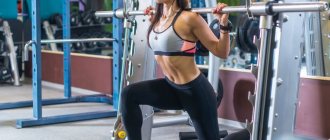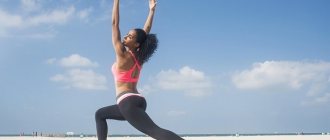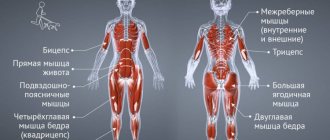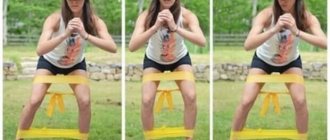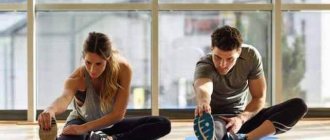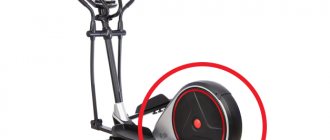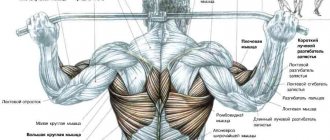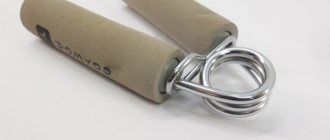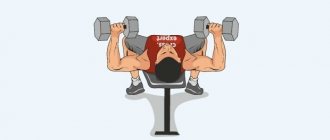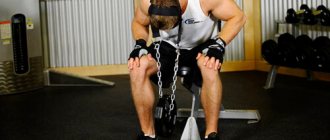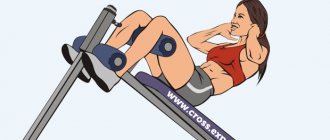The gluteus medius (GMM) is located on the lateral side of the buttock, under the iliac crest. The upper part of the muscle is wide and narrows as it passes into the tendon, giving it a fan-shaped shape. The gluteus maximus muscle covers all of the gluteal muscles, with the exception of the anterior-superior third of the SML. This open portion of the SMN is a safe area for intramuscular injections in the upper outer quadrant of the buttock.
You can listen to the glute podcast here.
Bret Contreras
Strength Coach and Performance Expert
To pump up the gluteal muscles, you need to meet two conditions: load them quite heavily (and increase the load over time) and learn to mentally concentrate on the working muscle.
Start your workout with a “heavy” exercise that allows you to move heavy weights—such as a barbell squat, Romanian deadlift, sumo deadlift, deadlift, or platform leg press. Keep a training diary and regularly record your progress in these exercises - weights, sets, repetitions. It is important to get enough rest between sets.
Finish the workout with lighter, isolation exercises such as frog pumps with dumbbells, glute bridges with a resistance band around the knees and dumbbells, hyperextensions without weights and the like.
Do more repetitions of these exercises and rest less in between. You don't have to count reps, but it is important to engage your glutes as you work and focus on the quality of each rep.
The combination of these two approaches allows you to work on your glutes with maximum impact.
Home inventory
You can pump up absolutely any muscle group at home – that’s a fact. However, training with your own weight is ineffective, so you need to take care of additional equipment.
Beginners who have never played sports before can work without weights. In this case, working with your own weight will help you learn to feel the muscles and prepare them for further load, but after 2-3 workouts you need to connect dumbbells.
You can train at home with fitness bands, also called elastic expanders. This is a small closed band that is placed on the legs to provide resistance when performing swings and squats. Fitness bands are sold as a set, have different resistance levels and are available at an affordable price, so they are definitely recommended for purchase by all fans of home workouts.
Another useful purchase would be leg weights. With their help you can pump up your buttocks, thighs and calves. For girls, a weight of 2-3 kg is recommended, for men - 3-4 kg. It is ineffective to use heavier weights, as this does not improve the results of the exercises, but it heavily hammers the calves and creates stress on the joints.
Bronwen Blunt
Nutrition and Strength Coach
You can't build a house without a foundation, so start with the "big" compound exercises - squats, deadlifts.
I see a lot of bikini athletes doing endless glute isolation and completely neglecting compound exercises in their programs. You won't build big, round buttocks by sitting on machines and doing endless reps all day. Build the foundation first, and after that, all other exercises will be more beneficial for your figure.
The three main exercises for strengthening and growing the buttocks are barbell squats, sumo deadlifts, and Bulgarian split squats.
Try adding some manipulation to your exercises to further challenge your muscles. For example, hold the glute contraction for 3-5 seconds at the top of the sumo lift at the end of each rep, or increase the negative phase (lowering the weight) to 5 seconds.
How do the buttock muscles grow?
The muscles of the buttocks increase in volume and grow in the same way as other muscles in our body. She must receive sufficient physical activity and the required amount of building material - protein. After the muscle has been loaded, the recovery process begins, this occurs after approximately 24 hours. Muscles damaged by physical activity begin to remove waste products from the tissues and require the body to supply amino acids. It is important to know here that muscle recovery and growth occurs only in a state of rest and relaxation.
What to eat to pump up? 10 Simple Foods to Gain Muscle Mass
Paul Carter
Strength and Bodybuilding Coach
Stop relying on squats and deadlifts alone to build your glutes. They are "activated" during these complex movements, but for most people this is not enough - the leg muscles often do a lot more work.
Of course, for some, squats and deadlifts may be enough to get well-developed gluteal muscles. But most people will need more work.
What is the function of the gluteal muscles? The gluteus medius is responsible for stabilizing the hip and knee when we stand on one leg, as well as abducting the hip to the side. Therefore, split squats and flyes in a seated machine are not such a bad idea.
For split squats, pause at the end of each set for about 10 seconds without fully extending your leg—this will cause your gluteus medius to burn. You can also do back lunges with dumbbells and yes, you can do them in a Smith machine too.
When it comes to hip abduction, some say it's not functional, but if you want to build a big round butt, they work great. Just use them correctly: hold a pause of 5 seconds at the end of each repetition and do the eccentric phase (lowering the weight) for 5 seconds as well. When you reach failure, do 5 forced repetitions, helping yourself with your arms. Do 3 sets of 15 reps like this, plus 5 forced reps at the end of the set, and tell me if your glutes don't get destroyed.
As for the gluteus maximus muscle, its main job is hip extension. The glute bridge is great, but most people use too much weight, which prevents full hip extension and maximum gluteal contraction. So it's better to go with a lighter weight and do 20 reps with a 3-second pause at peak contraction on each rep to better activate your glutes and extend your time under load rather than go for a world record weight.
Make sure your toes and knees are slightly turned outward to help contract your glutes as much as possible.
Gluteus medius muscle
The gluteus medius muscle is located in the upper lateral part of the buttock under the iliac crest. The muscle is wide at the top and tapers towards the insertional tendon, taking on a fan-shaped shape. The gluteus maximus muscle covers all gluteal muscles with the exception of the anteroposterior third of the gluteus medius muscle. This uncovered portion of the gluteus medius muscle is the safe site we use for intramuscular injections designed to be administered in the pelvic-gluteal-dorsal area.
Start
The gluteal or lateral surface of the ilium between the anterior and posterior gluteal lines and the gluteal aponeurosis. This is a large area that runs from the ilium above almost to the sciatic notch below.
Attachment
The gluteus medius muscle is divided into three parts, similar to the deltoid muscle of the shoulder joint.
- The fibers of the back pass forward and down.
- The fibers of the middle part pass downwards.
- The fibers of the front part run backwards and downwards. All fibers join together to form a flat tendon that attaches to the posterior and lateral superior portion of the greater trochanter of the femur.
Innervation
The gluteus medius muscle is innervated by the superior gluteal nerve (L4, L5 and S1 roots). Continuous supply is mainly provided by roots L1 and 2.
Blood supply
Deep branch of the superior gluteal artery, trochanteric anastomosis.
Function
- The gluteus medius muscle is the primary motor mechanism for abduction of the hip joint.
- The anterior part of the gluteus medius muscle abducts the thigh to the side and is involved in its flexion and medial rotation.
- The posterior part of the gluteus medius muscle abducts the thigh and is involved in its external rotation and lateral rotation.
- In hip flexion, all parts internally rotate the hip and, as shown, when the hip is flexed at 90 degrees, the driving force of the gluteus medius increases eightfold.
- All parts of the gluteus medius muscle participate in hip abduction, changing its position.
- The gluteus medius is an extremely important muscle in maintaining frontal plane stability of the pelvis, which it does in conjunction with the tensor fascia lata and the opposing quadratus lumbar muscle (lateral fascia), whose primary role is to provide frontal plane stability.
- The gluteus medius plays an important role in walking, running, and single-legged weight-bearing because it keeps the opposite side of the pelvis from sinking during walking, running, and single-legged weight-bearing. When one leg is lifted off the ground, the pelvis on the opposite side may drop due to insufficient support from below. The gluteus medius muscle supports the pelvis on this side, which tends to fall, thereby allowing us to bring the other leg forward to take the next step.
- The gluteus medius, together with the gluteus minimus and the tensor fascia lata, also supports the pelvis during a hip rotation gait. At the same time, the thigh is supported during the stance phase on the same side.
Gluteus medius clamp
As Vladimir Yanda said, the gluteus medius muscle is one of the phasic muscles in our body in which a “tightness” can occur for many reasons.
- The result of standing with the transfer of body weight mainly on one lower limb, while the pelvis rocks to the side and the hip is abducted to the side.
- Sleeping on your side without a bolster between your two lower limbs will result in the top leg being bent and pulled to the side in relation to the other leg.
- Sitting cross-legged for long periods of time potentially weakens the hip abductors, placing the muscle in a somewhat extended position (exceeding the state at physiological rest)
- Pinch the hip abductors, which direct reciprocal inhibition to the gluteus medius.
- When the gluteus medius is “tight”, the body must compensate for maintaining stability in the frontal plane with the help of other muscles and prevent the pelvis from descending, and thus the activity of the tensor fascia lata on the same side and the opposite quadratus lumborum muscle increases, leading to that these muscles become tense and hyperactive. N. _ B. _ Janda pointed out that the quadratus lumborum and tensor fasciae lata muscles are tonic muscles that can become tense and overactive.
- Weakness of these muscles is associated with pathologies of the musculoskeletal system and gait disturbances after a stroke.
- There is a relationship between gluteus medius weakness or dysfunction and many lower extremity injuries, such as Trendelenburg gait, iliotibial tract syndrome, patellofemoral pain syndrome, anterior cruciate ligament and other knee injuries, and ankle sprains.
- Trandelenburg syndrome means that a muscle cannot work effectively due to pain, poor mechanics or weakness, and the pelvis sinks to the opposite side of the weak muscle. The trunk is often compensated by the Trandelenburg gait. The results of one very impressive study on the validity of Trandelenburg syndrome suggest that trials should not be performed on healthy volunteers whose gluteus medius muscle strength exceeds 30% of their body weight (BW). It can only be carried out with the participation of significantly weaker patients. This means that you can actually have a tight gluteus medius muscle and not have Trandelenburg syndrome.
Activation of the gluteus medius muscle
There are many exercises that activate the gluteus medius muscle. Each exercise activates the gluteus medius muscle by a certain percentage, as shown by the electromyogram. We divided them as follows.
The prone plank differs from other exercises in that it is a static exercise to maintain a neutral hip and spine position during the exercise and focuses on the role of the gluteus medius in stabilizing the position of the hips and spine.
Survey
Palpation
Locate the middle of the ilium, which is located above the greater trochanter of the femur. Two fingers below is the main part of the gluteus medius muscle. The contraction of the muscle can be felt if you alternately transfer your body weight from one leg to the other.
Force
- Hip abduction in a lying position
- The period of support on one or two legs.
- Adding upper body movements while standing on one leg.
- Assess functional tasks that require support on one leg, such as stepping down, walking, or running.
Treatment
First of all, you need to find the cause of tightness or weakness in the gluteus medius and try to eliminate it and then try to activate the gluteus medius.
Pressman and colleagues described a developmental program to strengthen the gluteus medius muscle when it is weak.
- Non-weight-bearing and basic-load exercises such as shell exercises, side-lying hip abduction, upright hip abduction, and basic balance exercise while standing on one leg. Progress is considered if the patient can keep his pelvis level while standing on one leg in a stationary position for 30 seconds.
- Load-bearing exercises and progressively more difficult static exercises (i) by moving the center of gravity to a horizontal position while performing steps and/or jumps; (ii) with a decrease in the width of the base of the support; (iii) increasing the height of the center of gravity by lifting the arms and/or adding weight with the arms, or (iii) performing the exercise on an unstable surface.
- Sports exercises aimed at movement.
Trigger points of the gluteus medius muscle
see gluteus medius trigger points
Consequences of weakness and tension
Consequences of gluteus medius weakness
Weakness of the gluteus medius and minimus leads to a significant reduction in abduction strength, as they are the primary hip abductors. The functional consequences of this weakness are most apparent during weight-bearing exercise, especially single-limb weight bearing. The functional problem occurs while standing on the affected side. When an exercise begins and the abductor muscles are too weak to maintain balance, there is a tendency to force the pelvis to drop to the unsupported side. Because this is a very unstable condition and puts the subject at risk of falling, most subjects use a typical replacement. To avoid the pelvis falling onto the unsupported side, the subject tilts the torso towards the support (Fig. 39.13). This tilt moves the body's center of mass to the side of the hip joint. In this position, the weight of the upper body no longer tends towards the hips. In fact, body weight creates a small abduction torque, thereby eliminating the need for active abduction force. The resulting gait pattern is so characteristic of hip abduction weakness that it is called gluteus medius lameness, although it likely involves both the gluteus medius and gluteus minimus [32,42]. Perhaps the functional deficit resulting from weakness of the gluteus medius and minimus muscles would be better described as abductor lameness. (See Video in Chapter 28.)
Weak hip abduction is associated with anterior knee pain and the presence of hip osteoarthritis [3,24]. It is unclear whether abductor muscle weakness is a risk factor or a consequence of these disorders. More research is needed to determine whether strengthening these muscles can prevent or reduce the pain and dysfunction associated with the disorder. Clearly, clinicians should consider the role of the hip abductors in the treatment of people with lower extremity dysfunction.
Effects of tight gluteus medius
Abductor muscle tightness, although not common, does exist. Tightness of these muscles results in decreased range of adduction and possibly lateral rotation. This tension is found in people with arthritis, whose position of comfort often involves hip flexion and abduction. The functional consequences of abduction contracture are most often observed in the upright position and may include changes in the position of the pelvis to maintain an upright posture or in the position of other joints of the lower extremity to optimize support (Fig. 39.14).
Exercises for the gluteus medius muscle
see gluteus medius exercises
Gluteus medius stretch
see gluteus medius stretch
Massage of the gluteus medius muscle
see gluteus medius massage
Myofascial release of the gluteus medius muscle
see MFR of the gluteus medius muscle
Sources
- Palastanga N, Soames R. Anatomy and Human Movement: Structure and Function. 6th ed. London, United Kingdom: Churchill Livingstone; 2012.
- Kendall FB , McCreary EK , Provance PG .Muscles: Testing and Function, with Posture and Pain (Kendall, Muscles) Fifth, North American Edition. Philadelphia. Lippincott Williams & Wilkins, 2005. Jump up↑
- Reiman, M. P., Bolgla, L. A., & Loudon, J. K. A literature review of studies evaluating gluteus maximus and gluteus medius activation during rehabilitation exercises. Physiotherapy Theory and Practice, 2012: 28(4): 257–268.
- Presswood, L., Cronin, J., Keogh, J. W. L., & Whatman, C. . Gluteus Medius: Applied Anatomy, Dysfunction, Assessment, and Progressive Strengthening. Strength and Conditioning Journal. October 2008: 30(5):41–53
- Kim HJ, Lee HS, Jung HG. Difference of Muscle Activity by Pelvic Tilt in Side-Lying Hip Abduction.Journal of The Korean Society of Physical Medicine. 2022:12(3): 59-66.
- Barton CJ, Lack S, Malliaras P, Morrissey D. Gluteal muscle activity and patellofemoral pain syndrome: a systematic review. British journal of sports medicine. 2012 Sep 3:bjsports-2012.
- Buurke JH, Nene AV, Kwakkel G, Erren-Wolters V, IJzerman MJ, Hermens HJ. Recovery of gait after stroke: what changes?. Neurorehabilitation and Neural Repair. 2008 Nov 1;22(6):676-83.
- KendallK. D., Patel C., Wiley JP, Pohl MB, Emery CA, etal.Steps Toward the Validation of the Trendelenburg Test. Clinical Journal of Sport Medicine.jan 2013: 23(1): 45–51.
Tony Gentilcore
Strength Coach and Performance Expert
The answer is simple: whatever Bret Contreras advises is the best way to build a bigger glute.
The important thing here is not to be too “absolutist” in the exercises you gravitate towards. Some will say that for larger butts you need to do only glute bridges. Others will say that the only thing you need are heavy squats and deadlifts.
Actually, everything works. In the gluteal bridge, the muscles are maximally loaded in a reduced form. In squats and deadlifts - at the moment of stretching under load.
These are all important components to glute development, so stop arguing over semantics and realize that different things work differently. Try incorporating both into your program.
One of the protocols I use with my female clients is called the 5-10-15-20 method. The idea is to do four glute exercises, increasing the number of repetitions of each in sequence.
Workout A
1. Heavy squats or deadlifts - 5 reps per set
2. Kettlebell swings - 10 reps per set
3. Single leg glute bridge - 15 reps on each leg
4. Seated hip raises with band - 20 reps
Workout B
1. Heavy Glute Bridge with Barbell - 5 reps per set
2. Goblet Squats - 10 reps
3. Elevated Back Lunges - 15 reps on each leg
4. Side steps with band x 20 reps on each leg
- Do one exercise after another with minimal rest.
- “Heavy” exercises should not be performed to failure.
- Rest 60 seconds at the end of one circuit and repeat 2-3 circuits.
- Do this twice a week.
Goal of training
Before you figure out how to pump up the gluteus medius muscle, you should understand why you need to do it. It would seem that it is enough to regularly perform exercises for the large muscle in order to have strong and voluminous buttocks. However, many girls sooner or later encounter such a phenomenon as strong protrusion of the pelvic bones and flat lateral parts of the thigh. This occurs due to underdeveloped middle and small muscles. Thus, focusing on the middle part of this zone will allow you to round the figure, make the lines smoother and more harmonious, without weighing down the lower part of the body.
Men who want to train with heavy weights in the future cannot do without a developed gluteus medius muscle. This is because it stabilizes the lower body during deadlifts and weighted squats, as well as during leg kicks.
And one more important nuance - the developed middle muscle ensures an even distribution of the load between the pelvis and lower back. Thus, strong pelvic muscles will help avoid problems with the lumbar region. They also provide direct support to the hip joint and minimize the load on it, so the buttocks need to be fully developed, and not limited to two basic exercises.
Mark Dugdale
IFBB Pro Bodybuilder
My best advice for anyone who wants strong, great-looking glutes is to start every leg workout by activating and pre-exhausting your glutes. You'll see they perform better throughout the rest of your workout.
Here are a few of my top suggestions for butts:
- Glute Bridge: Pause each rep for 2 seconds at peak muscle contraction.
- Split squats with one leg on the bench: do drop sets (reducing the working weight several times per set as the muscle fatigues) with a pause of a few seconds at the end of the set.
- Prowler push: Take long, slow, deliberate strides using moderate weights on a sled.
Try starting every leg workout with one of these exercises. Alternate between them because they all activate the glutes differently.
Lee Boyce
Strength Coach and Performance Expert
Sprinting is one of the best ways to target the entire posterior kinetic chain, including the glutes. Take some time to learn how to do it technically.
I like step lunges with dumbbells because of their one-sided load. You can vary your step width to better target your glutes: taking longer steps and leaning your torso forward can create more impact. Dumbbells are the best option for this exercise because they reduce stress on the lower back.
Finally, we can't talk about glutes without a glute bridge. The problem people have is lifting too much weight and doing it like a lifter. If you lift too much weight, you won't be able to hit your glutes in isolation—other muscles in your body will come in to help with the heavy load. So reduce the weight and do more repetitions, concentrating on the muscles.
Christian Thibaudeau
Strength Coach and Performance Expert
If you want to improve the shape of your glutes, learn to incorporate them into compound, compound exercises—particularly squats, which can be very effective when done correctly.
The problem is that most people use their front thighs more than their glutes when squats. Try turning your hips and knees outward without lifting your feet off the floor. Imagine trying to screw your legs into the floor—the right one clockwise, the left one counterclockwise. This will help activate your glutes better and improve tension in them.
Throughout the entire movement - both when we lower and when we rise - we need to maintain this “spiral” tension. If you lose it, the body will revert to its normal way of lifting weights and shift the load to the quadriceps.
In the beginning, this may require you to lighten your weights and slow down your tempo to learn how to maintain tension. Once this becomes automatic, squats become more effective because you are now using two large muscles equally instead of just one.
To really focus on your glutes, use suspended squats: pausing for 2-3 seconds at the bottom of each rep. The key is not the pause itself, but what you do during it:
- Pause a few inches before you reach your bottom position in the squat.
- During the pause, maintain spiral tension.
- Stand up straight from the suspended position. Don't go down and bounce up by inertia.
This is my favorite technique for maximizing glute engagement in squats. Of course, it can only be used after you have learned how to properly create spiral tension.
Pumping up your buttocks is real
You need to understand that fashion models that appear in glossy magazines or on the Internet got their beautiful buttocks and hips as a result of long and painstaking work in the gym, which requires consistency and patience. You can, of course, work with your photo in Photoshop, but the result will remain only in the photo. Let's talk about how to create appetizing shapes for yourself in reality.
Small or large breasts are given by nature, and it is impossible to change this, except by learning to use this parameter for your own benefit. But it is quite possible to create beautiful buttocks for yourself if you have the desire. The attractiveness of the buttocks is determined by the development of muscle tissue, the absence of fat and maintaining muscle tone. All these parameters can easily be adjusted.
More often than not, the modern world dictates a sedentary lifestyle for women. Spending whole days in the office means not subjecting the muscles of the buttocks to stress at all - complete immobility leads to muscle degradation and loss of tone. If this is also accompanied by uncontrolled eating, then fat accumulations begin to form on the sides and buttocks, unpleasantly affecting the appearance.
Underdevelopment of the gluteal muscles as a “free supplement” ensures poor posture and weakening of the back of the thighs. The latter phenomenon leads to a disproportion in appearance: the buttocks look disproportionately large, despite the fact that they lack muscle tissue.
Dr. John Rusin
Strength Training Specialist and Performance Expert
People lift too much weight on the glute bridge in pursuit of its effectiveness and risk damaging their backs. Due to the lack of axial load, you can make a huge number of mistakes that cause problems in the lower back. It's a dynamic movement, and when it's poorly controlled and uses too much weight, the work doesn't happen as much in the glutes. Very often, people compensate for the upward push of the barbell by using their lower back, losing stability in the back and muscle control.
The gluteal bridge should be done with control of movement, with a pause in the upper position, from 8 repetitions and above. The glutes are the primary stabilizers of the pelvic-lumbar complex and can protect you throughout your life, so train them accordingly.
Clinically Relevant Anatomy
Origin of muscle
The gluteal or lateral surface of the ilium, between the posterior and anterior gluteal lines and the gluteal aponeurosis. This is a large area extending from the iliac crest above to the sciatic notch below.
Attachment of muscle
The SMN is divided into three parts, resembling the deltoid muscle of the shoulder joint.
- Fibers from the back, moving forward and down.
- Mid-section fibers running downwards.
- Fibers from the front, running back and down. All fibers unite to form a flattened tendon, which is attached to the posterior and lateral part of the superior part of the greater trochanter of the femur.
Innervation
The SMN is innervated by the superior gluteal nerve (roots L4, L5 and S1). Cutaneous innervation is mainly provided by L1 and 2.
You can read about the gluteus maximus muscle here.
Eric Bach
Strength Coach and Performance Expert
To build strong, great-looking glutes, you need to combine two training factors: high mechanical stress and metabolic stress.
Build a foundation with exercises that allow the muscles to develop a lot of mesonic tension—squats, deadlifts, and, of course, glute bridges. Do 3-5 sets of 3-8 reps and add weight to the bar over time. This will help you engage your fast-twitch muscle fibers as much as possible.
This is followed by exercises to create metabolic stress in the muscle, performed in isolation, repetitively and with a short rest period.
Example workout:
- A. Barbell squats – 4 x 5
- IN 1. Gluteal bridge. 3 sets: in the first 8-10 repetitions, in the second 6-8, in the third 12-15, rest 45 seconds. AT 2. Back lunges with dumbbells - 3x8 on each leg, rest 45 seconds
- C. Romanian deadlift with dumbbells - 3 x 12, rest 60-90 seconds
- D1. Kettlebell swings - 5 times D2. Squats with a kettlebell - 5 times D3. Reverse Cup Lunges - 5 times Repeat the D1-2-3 pattern as many times as you can in eight minutes.
- E. Side steps with tape around knees? with a countdown from 10 to 1: 10 steps to the right + 10 to the left, 9 steps to the right + 9 to the left and so down to one.
